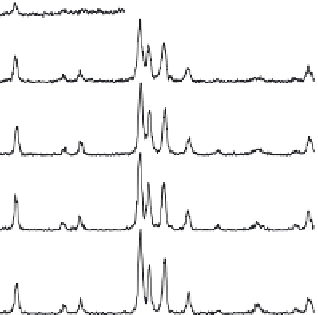Biomedical Engineering Reference
In-Depth Information
TP
TCP
CaO
VH400
AH400
AH500
VH500
AH600
VH600
AH700
VH700
VH800
AH800
25
30
35
40
25
30
35
40
2
θ
2
θ
FIGURE 6.7
X-ray diffraction patterns of plasma-sprayed HACs with applying postvacuum heat treatment (VH series) and
atmospheric heat treatment (AH-series) at 400°C to 800°C. (From Yang, C.W. and Lui, T.S.,
Mater. Trans
., 48(2),
211-218, 2007. With permission.)
According to the phase diagram of CaO-P
2
O
5
system as shown in Figure 6.2, since there
is a lack of ambient partial water vapor pressure during vacuum heating, TCP and TP
phases cannot be eliminated without the replenishment of OH
−
groups. In addition, the
CaO remained within both of the heat-treated HACs because it cannot easily be converted
into HA if the ambient heating atmosphere is without abundant H
2
O molecules [54,59].
Heat treatment is recognized as a proven process of controlling the amount of amor-
phous calcium phosphate and quantification of the amorphous component has also been
attempted by many studies [45,60,64,101,108-111,117]. In order to evaluate the content of
ACP and other impurity phases displayed in Figure 6.7, the internal standard method
[118] is one of the most common methods to quantitatively determine the fluctuation of
phase composition within the heat-treated HACs. The integral intensity of known weight
percent pure Si powder added in the specimens is taken as the internal standard. Wang
et al. [45] and Chou and Chang [117] have established the calibration curves for calculat-
ing the content of ACP, TCP, TP, and CaO phases. The main peak integral intensity ratio
between TCP, TP, CaO, and HA phase from various XRD patterns of heat-treated HACs
are compared to the calibration curves and the concentrations (in wt.%) of these phases in
various coatings are calculated. Figure 6.8 shows the impurity phase content at different
temperatures for the vacuum heat-treated HACs (VH series). The impurity phases gener-
ally tend to decrease when the increased heating temperature reaches 600°C, at which
the HACs contains the lowest content (about 20.3 wt.%) of total impurity phases. There is
also a continuous decrease in amorphous content with increasing temperatures. However,
when the heating temperature rises to a temperature range of 600°C to 800°C in vacuum,
a significant increasing trend of impurity phases content (mostly TP and CaO phases)
resulting from the decomposition of HA [54,101] can be recognized as the temperature
increases further, resulting in greater total impurity phases about 26.1 wt.% at 800°C. For






























Search WWH ::

Custom Search